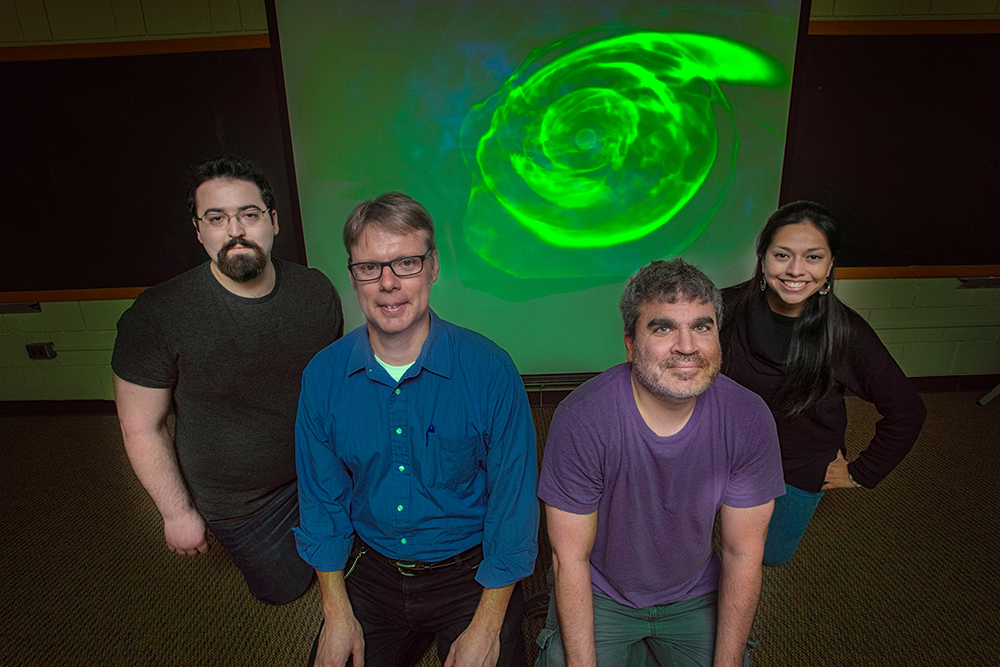
| Professors Michael Zingale (front, right) and Alan Calder (front, left) will lead a team using supercomputing hours to model explosive astrophysical phenomenon such as white dwarfs (in background). Graduate students Donald E. Willcox and Maria Barrios Sazo are part of the team. |
Stony Brook, NY, November 16, 2015 – A national research team led by Stony Brook University has been awarded 45 million hours of on one of the world’s fastest supercomputers, the Titan Cray XK7 at Oak Ridge National Laboratory, to further their research on explosive astrophysical phenomenon and model these complex occurrences by way of supercomputer-generated simulations. The award, sponsored by the U.S. Department of Energy’s Office of Science through its Innovative and Novel Computational Impact on Theory and Experiment (INCITE) Program, recognizes national research projects with high potential for accelerating discovery.
The project, titled “Approaching Exascale Models of Astrophysical Explosions,” is led by Michael Zingale, PhD, and Alan Calder, PhD, Stony Brook University Professors in the Department of Physics and Astronomy. The project is one of only six nationally in the area of astrophysics to be awarded by the 2017 INCITE Program. The team received a similar award for supercomputing hours in 2014. See this link for the complete list of 2017 awardees.
The research team will carry out a comprehensive study of stellar explosions and their precursors using a suite of simulation codes. The collaboration will study a host of astrophysics problems, and of particular interest to the Stony Brook team are problems powered by fusion reactions.
“The award and our continued use and development of simulations using this world-renowned supercomputer will further advance our understanding of astrophysical explosions,” said Professor Calder, also an affiliate of the Institute for Advanced Computational Science (IACS) at Stony Brook.
Professor Calder added that more specifically, the team will investigate problems involving explosions occurring either on the surface or the interior of compact stars. For example, if a compact star, a white dwarf or a neutron star, gains material on its surface from a companion star, then that surface layer can suddenly experience a thermonuclear runaway and explode. Or, in the case of a white dwarf, the whole star can explode.
“The supercomputer hours broadens our ability to explore a multitude of configurations of these stellar explosions,” explained Professor Zingale, also an affiliate of IACS. “Our focus will be on X-ray bursts, which are a layer of transferred material on the surface of a neutron star that explodes, and thermonuclear supernovae, the explosion of a white dwarf star.”
Both Professors Calder and Zingale have received supercomputer hours from numerous INCITE program awards in previous years. Two graduate students from the Department of Physics and Astronomy, Maria Barrios Sazo and Donald E. Willcox, will be part of the research team for the 2017 award.
The project also includes co-investigators from Lawrence Berkeley National Laboratory, Oak Ridge National Laboratory, the University of California, Los Alamos National Laboratory, and the University of Tennessee.
The INCITE Program promotes transformational advances in science and technology through large allocations of time on state-of-the-art supercomputers. See this link for more on the INCITE Program.
Greg Filiano
Media Relations Manager, School of Medicine, Stony Brook University
Office: 631.444.9343
gregory.filiano@stonybrookmedicine.edu